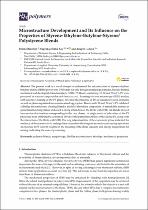 ResearchSpace
ResearchSpace
Microstructure development and its influence on the properties of styrene-ethylene-butylene-styrene/polystyrene blends
JavaScript is disabled for your browser. Some features of this site may not work without it.
- ResearchSpace
- →
- Research Publications/Outputs
- →
- Journal Articles
- →
- View Item
| dc.contributor.author |
Banerjee, R

|
|
| dc.contributor.author |
Ray, Suprakas S

|
|
| dc.contributor.author |
Ghosh, AK

|
|
| dc.date.accessioned | 2018-12-03T12:50:05Z | |
| dc.date.available | 2018-12-03T12:50:05Z | |
| dc.date.issued | 2018-04 | |
| dc.identifier.citation | Banerjee, R., Ray, S.S. and Ghosh, A.K. 2018. Microstructure development and its influence on the properties of styrene-ethylene-butylene-styrene/polystyrene blends. Polymers, vol. 10(4): 400 | en_US |
| dc.identifier.issn | 2073-4360 | |
| dc.identifier.uri | https://www.mdpi.com/2073-4360/10/4/400 | |
| dc.identifier.uri | https://doi.org/10.3390/polym10040400 | |
| dc.identifier.uri | http://hdl.handle.net/10204/10576 | |
| dc.description | This is an open access article distributed under the Creative Commons Attribution License which permits unrestricted use, distribution, and reproduction in any medium, provided the original work is properly cited (CC BY 4.0). | en_US |
| dc.description.abstract | The present work is a novel attempt to understand the microstructure of styrene-ethylene-butylene-styrene (SEBS)/polystyrene (PS) blends not only through morphological studies, but also thermal, mechanical and rheological characterizations. SEBS/PS blends containing 10, 30 and 50 wt % PS were processed in a micro-compounder and characterized. Scanning electron microscopy (SEM) studies, with selective staining of the PS phase, revealed the presence of PS as nanometer-sized domains, as well as phase-separated micrometer-sized aggregates. Blends with 30 and 50 wt % PS exhibited a fibrillar microstructure, obeying Hirsch’s model of short fiber composites. A remarkable increase in glass transition temperature indicated a strong interaction of the fibrils with SEBS. All blends showed two modes of relaxation corresponding to the two phases. A single mode of relaxation of the PS phase has been attributed to combined effects of the partial miscibility of the added PS, along with the interaction of the fibrils with SEBS. The long relaxation time of the elastomeric phase indicated the tendency of these materials to undergo time-dependent shrinkage in secondary processing operations. An increase in PS content resulted in the lowering of the shear viscosity and energy requirement for mixing, indicating the ease of processing. | en_US |
| dc.language.iso | en | en_US |
| dc.publisher | MDPI | en_US |
| dc.relation.ispartofseries | Worklist;21729 | |
| dc.subject | Polymer blends | en_US |
| dc.subject | Morphology | en_US |
| dc.subject | Fibrillar microstructure | en_US |
| dc.subject | Rheology | en_US |
| dc.subject | Mechanical properties | en_US |
| dc.title | Microstructure development and its influence on the properties of styrene-ethylene-butylene-styrene/polystyrene blends | en_US |
| dc.type | Article | en_US |
| dc.identifier.apacitation | Banerjee, R., Ray, S. S., & Ghosh, A. (2108). Microstructure development and its influence on the properties of styrene-ethylene-butylene-styrene/polystyrene blends. http://hdl.handle.net/10204/10576 | en_ZA |
| dc.identifier.chicagocitation | Banerjee, R, Suprakas S Ray, and AK Ghosh "Microstructure development and its influence on the properties of styrene-ethylene-butylene-styrene/polystyrene blends." (2108) http://hdl.handle.net/10204/10576 | en_ZA |
| dc.identifier.vancouvercitation | Banerjee R, Ray SS, Ghosh A. Microstructure development and its influence on the properties of styrene-ethylene-butylene-styrene/polystyrene blends. 2108; http://hdl.handle.net/10204/10576. | en_ZA |
| dc.identifier.ris | TY - Article AU - Banerjee, R AU - Ray, Suprakas S AU - Ghosh, AK AB - The present work is a novel attempt to understand the microstructure of styrene-ethylene-butylene-styrene (SEBS)/polystyrene (PS) blends not only through morphological studies, but also thermal, mechanical and rheological characterizations. SEBS/PS blends containing 10, 30 and 50 wt % PS were processed in a micro-compounder and characterized. Scanning electron microscopy (SEM) studies, with selective staining of the PS phase, revealed the presence of PS as nanometer-sized domains, as well as phase-separated micrometer-sized aggregates. Blends with 30 and 50 wt % PS exhibited a fibrillar microstructure, obeying Hirsch’s model of short fiber composites. A remarkable increase in glass transition temperature indicated a strong interaction of the fibrils with SEBS. All blends showed two modes of relaxation corresponding to the two phases. A single mode of relaxation of the PS phase has been attributed to combined effects of the partial miscibility of the added PS, along with the interaction of the fibrils with SEBS. The long relaxation time of the elastomeric phase indicated the tendency of these materials to undergo time-dependent shrinkage in secondary processing operations. An increase in PS content resulted in the lowering of the shear viscosity and energy requirement for mixing, indicating the ease of processing. DA - 2108-04 DB - ResearchSpace DP - CSIR KW - Polymer blends KW - Morphology KW - Fibrillar microstructure KW - Rheology KW - Mechanical properties LK - https://researchspace.csir.co.za PY - 2108 SM - 2073-4360 T1 - Microstructure development and its influence on the properties of styrene-ethylene-butylene-styrene/polystyrene blends TI - Microstructure development and its influence on the properties of styrene-ethylene-butylene-styrene/polystyrene blends UR - http://hdl.handle.net/10204/10576 ER - | en_ZA |





